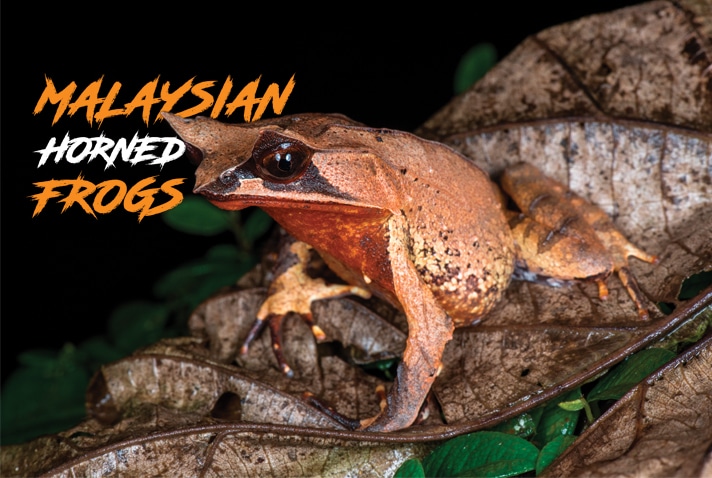Get hooked on these awesome anurans.
What’s big, looks like a leaf, and sounds like a goose? If you’ve read the title of this article, you may have guessed it — the Malaysian horned frog! These large, terrestrial anurans have long been popular in the pet trade, but are nearly all wild caught adult males. The bulk of these captives, like many wild caught animals, do not do well in the confines of glass reptile terrarium. Fortunately, captive bred animals are becoming more available and with the right husbandry and amphibian supplies, they can thrive.
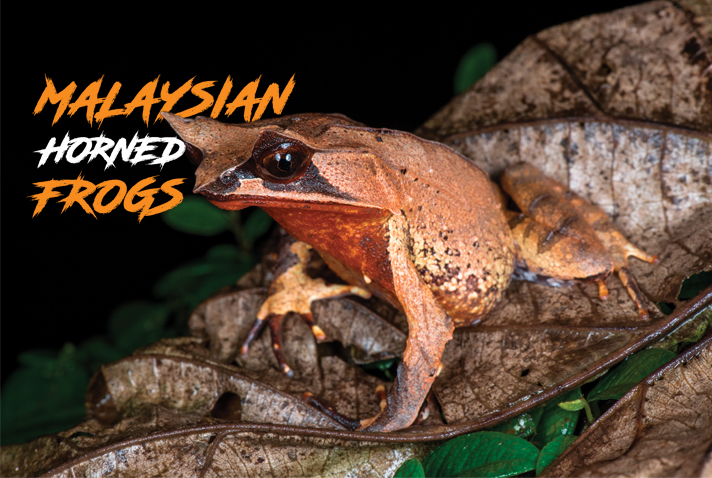
Norjipin Saidi/Shutterstock
The Malaysian horned frog resembles a leaf, as it is known to frequent leaf litter.
Physical Appearance of the Malaysian Horned Frog
The first thing most people notice about this species is their striking camoflauge. From their pointed noses to their brown, tan, black, and red coloration, everything about the color and shape of these anurans is meant to mimic leaves. Even their namesake — the horn-like projections above their eyes — is meant to break up their outline and allow them to melt into their surroundings.
These are BIG frogs. Females can easily measure over 5 inches in length, while males are typically closer to 3.5 inches long. Approximately 99 percent of the wild caught frogs that are imported are males (the only surefire way to collect these from the forest is to follow their call), but an adult female is a sight to behold — they’re huge!
Pair this frog’s angular yet organic appearance with large, black eyes and you have one alien looking critter!
Native Range of the Malaysian Horned Frog
The Malaysian horned frog (Megophrys nasuta) is native to peninsular Malaysia, Singapore, Thailand, and Indonesia, where it is common in appropriate habitat. It is found in primary forest, at lower elevations, where plenty of leaf litter and cover exists. Cover is important, as horned frogs utilize leaf litter and other cover to blend into their surroundings and wait for prey to wander by. These frogs are almost always found fairly close to clear, fast moving forest streams which they utilize for breeding. When considering keeping these fascinating frogs in captivity, what should you take away from this?
- Large habitat with plenty of room to jump
- Access to clean water
- Plenty of cover and leaf litter
Malaysian Horned Frog Husbandry and Habitat
Malaysian horned frogs are big frogs, and as such require a big habitat. Wild-caught frogs in particular are demanding. Even smaller males should really be housed in a terrarium with at least a 36-inch by 18-inch footprint, and females (the larger of the sexes) require even larger accommodations. At Josh’s Frogs, we house 2:1 (2 males, 1 female) groups in custom 7-inch by 24-inch terraria, and they utilize every square inch of space. If you’re wanting to keep these big frogs, be ready for a big habitat.
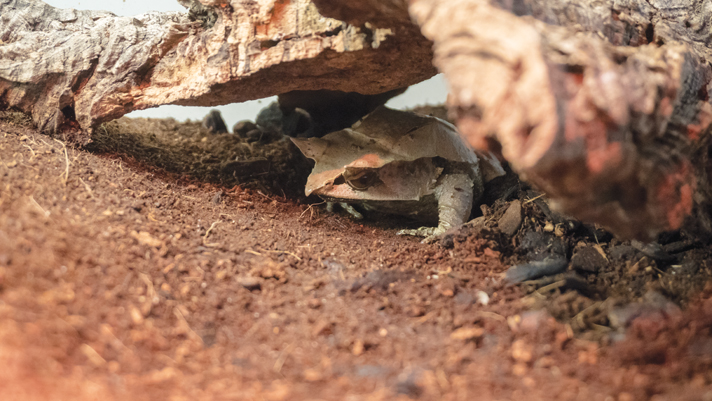
zach brinks
Female Malaysian horned frog taking shelter. Provide some caves or tunnels for the frogs.
Fortunately, if acquiring captive bred frogs, froglets can be initially housed in something much smaller. At Josh’s Frogs, we house our captive bred Malaysian horned frogs in large 10-inch diameter deli cups for the first three to four months at a time. After four to five months, they move up to 10 gallon tanks, like the Zilla Tropical 10-gallon starter terrarium, before being moved to adult size habitats.
Ideal Substrate for Malaysian Horned Frogs
For young Malaysian horned frogs, keep the amphibian substrate simple. Damp paper towels changed every two to three days, paired with a handful of damp sphagnum moss to act as a humid hide is the way to go. You can also use a small amount of Zilla Fir & Sphagnum Peat Moss Mix Bedding. You can add a bit of leaf litter or an artificial plant if you feel the need to, but it’s best to keep the setup simple to allow for easy monitoring of the froglets.
As they age, older Malaysian horned frogs can be kept on coco fiber, or a bioactive substrate such as BioBedding Tropical. These frogs are ambush predators, and like to dig down slightly into the substrate to form a shallow hollow to sit in and wait for prey to pass by. I personally recommend keeping them in a bioactive enclosure. Seeding the substrate with springtails and isopods will take care of any waste produced, and a healthy layer of Magnolia or live oak leaves will provide plenty of hides and create humid niches for the frogs to utilize.
Décor for Malaysian Horned Frogs
Your future pet Malaysian horned frog is probably a lot less picky about what the frog habitat products looks like than you will be. These large frogs like to sit tight and blend in, so make sure to provide visual barriers (especially if keeping them in groups) and opportunities to hide. Leaf litter (dried, brown leaves from Magnolia or live oak trees) is strongly recommended. Malaysian horned frogs have evolved to live in the leaf litter—they look like a leaf, after all!
Cork, Malaysian driftwood, or Manzanita wood, or any solid woods that will hold up in a humid environment, are great choices. Avoid pieces with sharp edges or points—your frog may accidentally injure itself while moving around. Try and provide some caves or tunnels for the frogs to take shelter in. The Zoo Med Habba Hut is also available. Fake plants are perfectly fine, or you can go the live plant route. Pothos, philodendron, and any other robust, tough plants that will grow well in a high humidity environment with low light levels should thrive. Live plants will help increase humidity, provide cover and visual barriers, and uptake nutrients from the substrate, helping to keep your Malaysian horned frog’s enclosure clean.
Water is Important for Your Malaysian Horned Frog
Keep a large, shallow water bowl in your horned frog’s enclosure at all times. Make sure the water bowl is easy for your frog to get in and out of—these frogs are clumsy! Make sure to keep the water clean by changing it daily with dechlorinated tap water. Once a week, clean the water bowl with a mild bleach solution or an amphibian safe cleaner.
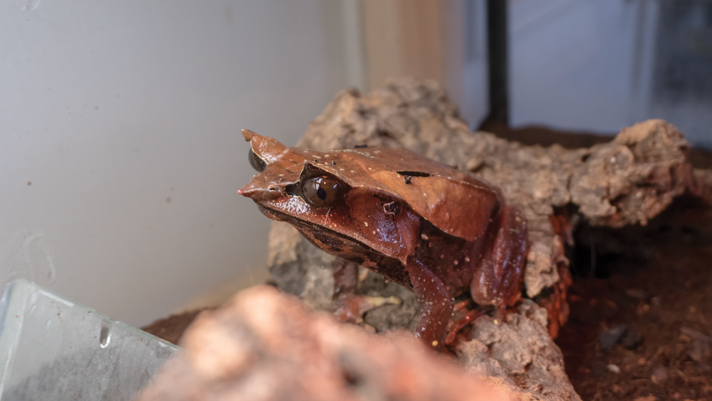
zach brinks
Malaysian horned frogs are captive-bred and these are the ones that you should seek out.
Alternatively, a large water feature, such as a pond, can be provided. Make sure to do regular water changes if you decide to go this route, and ensure the water feature is not more than a few inches deep. These frogs do breed in forest streams and providing them access to a large, shallow body of clean water is necessary for reproduction.
Malaysian horned frogs should be misted one- to two- times a day using a reptile mister. They come from humid jungles, and misting will help maintain the humidity they need to thrive, as well as help water any live plants.
Malaysian Horned Frog Lighting
Hailing from under a dense rainforest canopy, Malaysian horned frogs do not absolutely need UVB light to thrive. At Josh’s Frogs, we provide them with a low level, 2.0 UVB source. Literature suggests similar species are occasionally exposed to UV, and there is no harm in providing it in low doses.
In general, you’ll want to provide a low level of light just bright enough to be able to observe your horned frogs. If you’re using live plants in the habitat, ensure they’re suitable for plant growth. Lights with a color temperature of 6500K will produce a clean, bright light that’s great for watching frogs and plant growth. Keep lights on 12 hours a day. Avoid exposure to natural sunlight, as this can quickly cause a glass enclosure to heat up to lethal levels.
Basking bulbs or hot spots are generally not needed, but can be used to increase ambient temperature if it is too low. Our adult Malaysian horned frogs were recently moved into a hallway that can be a bit chilly. Mini halogen dome lights with 25w red bulbs from Zilla ensure they do not get too cool, especially at night.
Ideal Temperature and Humidity for Your Malaysian Horned Frog
Hailing from the tropics, it’s easy to guess how horned frogs like it — warm and humid. We’ve found their ideal temperature is around 72-74°F. They can tolerate temperatures down to the mid 60s, but I would not recommend leaving them exposed to lower temperatures for long. Temperatures over 80°F can prove fatal, with temperatures in the high 80s quickly doing in these otherwise robust amphibians. Enclosure temperatures should be carefully monitored with a digital thermometer.
Humidity control for this species can be a bit tricky. Malaysian horned frogs like it humid, but they cannot tolerate stagnant conditions. The adult frogs require a bit of ventilation. At Josh’s Frogs, we maintain them in glass terraria with screen tops, like those offered from Zilla. Covering about half of the screen top with pieces of glass helps maintain humidity, while allowing enough ventilation. The goal is to have the surface of the substrate to just start to dry out before the next misting. With an ambient air humidity of about 40 percent, we mist twice a day. Humidity should always be closely monitored with an accurate digital hygrometer. Approximately 95 percent of the time, when something goes wrong while keeping an amphibian it’s due to improper temperature or humidity.
Feeding Your Malaysian Horned Frog
Healthy Malaysian horned frogs are pigs, and seem deadset on eating you out of house and home. These frogs have large mouths and as such can eat correspondingly large prey. Our adult females routinely consume adult female dubia roaches without a problem.
Malaysian horned frogs are pretty large right out of the water, and can start life eating melanogaster fruit flies or pinhead crickets. They grow quickly, and are generally able to chow down on the slightly larger hydei fruit flies or 1/8-inch crickets within a couple weeks.
After four to six weeks, these cryptically colored anurans can typically take ¼-inch crickets. At Josh’s Frogs, we prefer banded crickets. This tropical species of cricket moves more than the common European house cricket, and seems to entice the frogs to eat more.
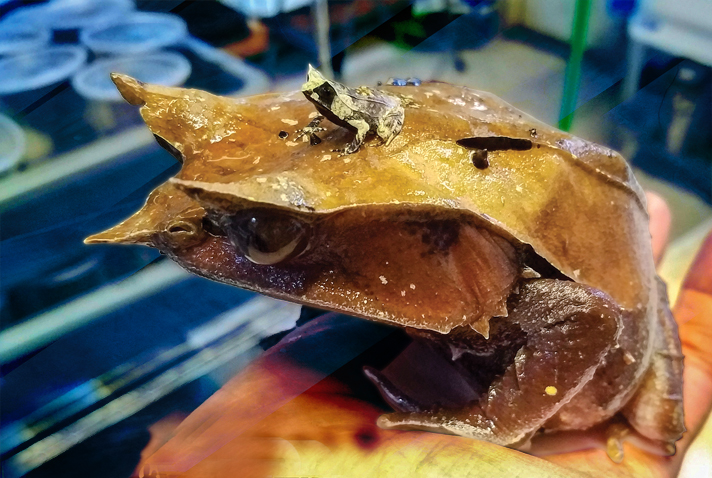
zach brinks
First out of water. A 1.5 month old Malaysian horned froglet and mother.
As the frogs grow, they’ll be able to eat larger frog food (prey items.) After about half a year, the frogs will be able to easily chow down on ½-inch crickets and ¼-inch dubia roaches. You can also offer them medium sized black soldier fly larvae as well as the occasional wax worm.
Adult male Malaysian horned frogs will feast on 1-inch adult banded crickets, as well as ¾-inch dubia roaches, large black soldier flies, and even the occasional hornworm. Adult female frogs will consume all of the above, and even adult female dubia roaches. Some keepers offer the occasional pinkie mouse. While the occasional mouse will not harm your frog, too many can result in corneal lipidosis, a fatty deposit that forms in the frog’s eyes, causing it to go blind. We have been very successful keeping and breeding Malaysian horned frogs without ever offering them mice.
At Josh’s Frogs, we feed prey items without using a food bowl when the frogs are kept on paper towel. On any loose substrate, the frogs are fed in bowls or tong fed. We have not had an issue with impaction, but due to how difficult (and expensive!) it is to acclimate wild caught adult Malaysian horned frogs, we don’t want to risk it! Tong feeding allows us to carefully monitor the health of the frogs, and ensure each frog gets plenty to eat when housed in a group setting.
All prey items should be dusted with a quality vitamin and mineral supplement. We dust with a calcium and D3 supplement twice a week and a multivitamin weekly. Make sure to keep your supplements in air tight containers in the fridge, and replace them every six months. Folic acid and vitamin A can be offered to mature animals in breeding condition every month. Gutloading feeder insects is also a great way to ensure that your Malaysian horned frogs are getting proper nutrition. Ideally, feeder insects are fed a nutritious diet for at least 48 hours before being fed to your frogs. We offer up Cricket Cuisine or Roach Rations, in addition to carrot or sweet potato, to all crickets and dubia roaches that are fed to our frogs.
Choosing a Malaysian Horned Frog
Now that you know how to properly care for a Malaysian horned frog, it’s time to learn how to pick one out. There are two sources for Malaysian horned frogs in the pet trade; captive-bred and wild caught. Wild-caught animals have been removed from the jungles of their native range, packed in suboptimal conditions, and shipped to an importer in the United States, typically in Miami. Then, they’ve been handed off to a wholesaler, before ending up for sale to you.
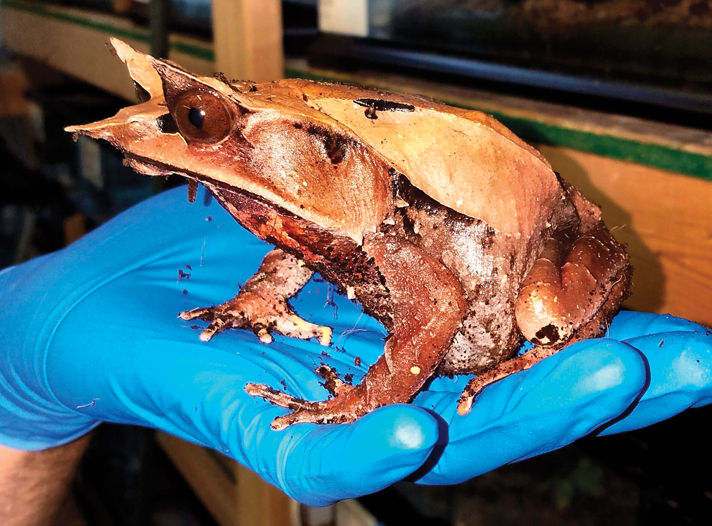
zach brinks
Captive-bred animals are already acclimated to the conditions they’ll be exposed to in the pet trade.
Depending on the source, there could easily be another two- to- three steps for them to get to you. During this time, the frogs may not be housed or cared for appropriately — it’s no wonder that wild caught animals can be difficult to keep alive! Wild caught animals are best left to be purchased by breeders or those with a lot of amphibian experience. If you do end up purchasing wild caught horned frogs, make sure to test for Chytrid fungus. Ranavirus should also be tested for, as this can easily spread to other frogs and is fatal. Fecal testing should be done by an experienced vet to check for internal parasites. Also give the frog a good once over. On more than one occasion, I’ve pulled a leech off a wild-caught Malaysian horned frog!
Captive-bred animals, on the other hand, are already acclimated to the conditions they’ll be exposed to in the pet trade. They’re typically much hardier, have a much lower chance of carrying parasites or harmful diseases, and tend to make better pets. If you ever have the chance to purchase captive bred animals, do so. They may cost a bit more than their wild caught counterparts, but it’s much easier to be successful when starting with captive bred animals. While captive bred Malaysian horned frogs are currently quite rare, some frog breeders such as Josh’s Frogs are working to produce enough animals to satisfy the demand for these amazing animals.
Malaysian horned frogs have large clutches — just a few successful breeding events a year are capable of producing enough captive-bred offspring for the entire pet trade in the United States.
Before purchasing an animal, talk to the supplier. Ask about the source of the animal. Did the seller produce them? If not, where were they sourced from? How old is the animal? How long has it been in their care? Malaysian horned frogs are pigs, and should appear quite plump. The horn-like projections above their eyes and their nose should be pointed – stressed frogs, or those housed in improper conditions, may rub these off against a side of the enclosure. Once disturbed, the frog should hold its head off the ground. Animals that appear skinny, have retained shed, or are not responsive when disturbed are a sign that no Malaysian horned frogs should be purchased from that source.
Breeding Malaysian Horned Frogs
Breeding Malaysian horned frogs is a very infrequent occurrence, both in the private hobby and zoo setting. In captivity, it’s important to cycle your frogs. Adults should be fed and misted less for several months, before feeding and misting much more often for a couple months before attempting to breed. In the wild, males call for females along the edge of a jungle stream with relatively cool, highly oxygenated moving water. Once a suitable female shows up, they amplex (basically, the male latches onto her back in order to fertilize eggs) for several days to several weeks. Eventually, after eggs are ripe and a suitable spawning site has been found, the female sticks 1,500-4,000 eggs in long rows on a flat surface right beneath the surface of the water.
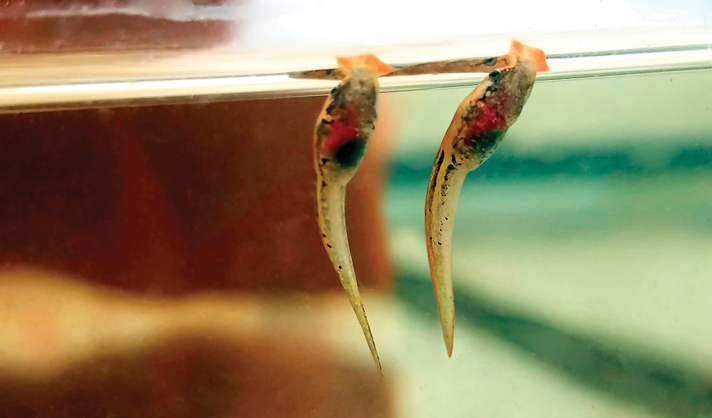
zach brinks
Malaysian horned frog tadpoles.
It’s important that you ensure a large enough surface is present. During our first breeding attempt, a surface area only about 10 inches in length was provided, and eggs were laid on top of eggs, leading to 90 percent of the eggs failing to develop. We increased available egg laying surfaces for our second breeding attempt and were able to hatch about five times the eggs.
A large pond area (4 square feet) is provided in the breeding tank, with plenty of cork bark half longs the frogs can enter and lay eggs inside.
The eggs will appear as little white/yellowish white spheres. They do not show any signs of development for about the first week, until a small ridge will be visible on top of the egg. This eventually develops into the tadpole, which will hatch and swim out after three to four weeks. After the tadpoles have hatched, we remove them to tadpole rearing bins, where they receive daily water changes. Several air stones provide plenty of oxygenation. The tadpoles are surface feeders (made evident by the odd, funnel like projection on their lower jaw), so they do best with several small feedings of powered frog and tadpole food a day. At Josh’s Frogs, we created our own Tree Frog and Toad Tadpole Food powder that works great with this species. Any excess food is quickly consumed by Corydoras catfish present in the tank, and removed during the daily water changes. We also provide some floating cork for cover, as well as a few indian almond leaves and java moss to help keep the water clean and acidic. The water is heated with a submersible water heater to a temperature of 76°F.
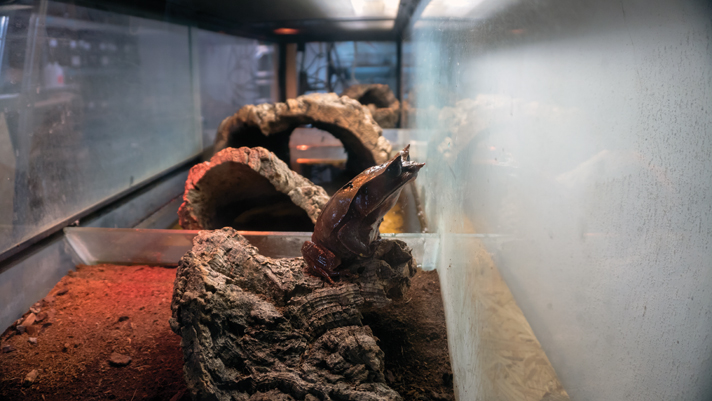
zach brinks
Malaysian horned frog breeding setup.
After four months, tadpoles will begin to leave the water. We find most of the froglets hanging out on the floating pieces of cork. Tadpoles will continue to leave the water over the next eight to 10 months. It can be over a year before all tadpoles have morphed into froglets! The froglets grow quickly and are ready for sale at three to four months of age.
Conclusion
The Malaysian horned frog is a large, tropical amphibian with a lot of character. Its cryptic, foreign appearance ensures it’ll always have a place in the pet trade. These are big frogs that require big enclosures, but the reward from properly keeping them is equally large.
While it is considered common in its natural range, wild caught horned frogs do not do well in captivity and importation does not provide a long term solution to keeping these amazing anurans around in the pet trade. We owe it to not only keep these animals alive in captivity, but to create a sustainable trade of captive bred Malaysian horned frogs for future generations to enjoy.
Zach Brinks is a lifelong herper. He’s kept and bred reptiles and amphibians since he was 5, and has bred over 100 species of herps in the past three decades. Zach now oversees the animal breeding operations at Josh’s Frogs, the largest pet amphibian breeding operation in the world, where he works with a talented team of fellow herpetoculturists to produce healthy, captive bred reptiles and amphibians for the pet trade and zoos all over the world. He has a B.S. In biology from Michigan State University.

